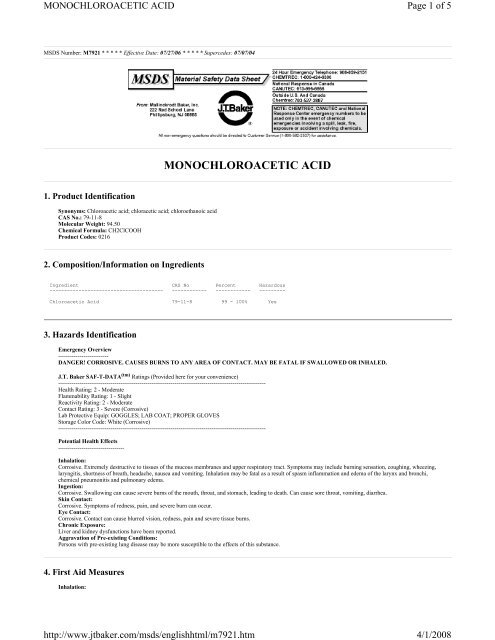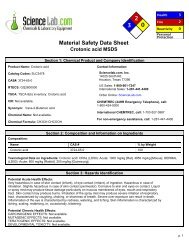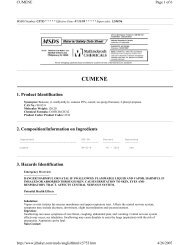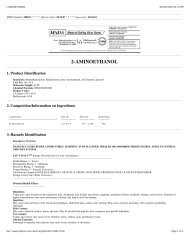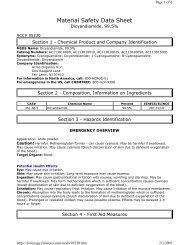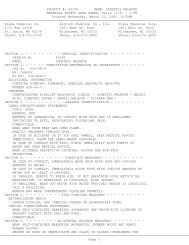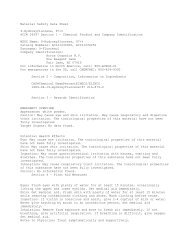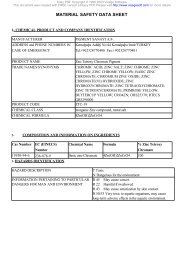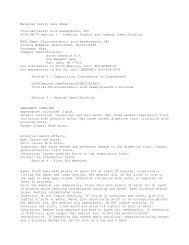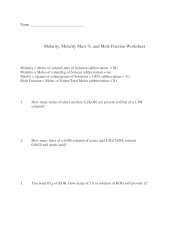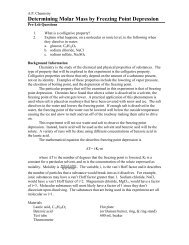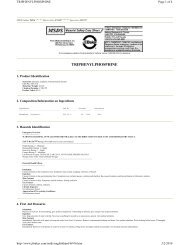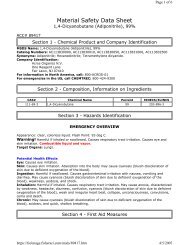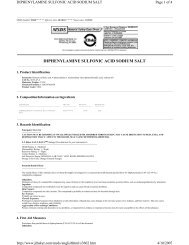MSDS PDF/M/MONOCHLOROACETIC ACID.pdf
MSDS PDF/M/MONOCHLOROACETIC ACID.pdf
MSDS PDF/M/MONOCHLOROACETIC ACID.pdf
Create successful ePaper yourself
Turn your PDF publications into a flip-book with our unique Google optimized e-Paper software.
<strong>MONOCHLOROACETIC</strong> <strong>ACID</strong>http://www.jtbaker.com/msds/englishhtml/m7921.htmPage 2 of 54/1/2008Remove to fresh air. If not breathing, give artificial respiration. If breathing is difficult, give oxygen. Call a physician immediately.Ingestion:DO NOT INDUCE VOMITING. Give large quantities of water. Never give anything by mouth to an unconscious person. Call a physician immediately.Skin Contact:Immediately flush skin with plenty of water for at least 15 minutes while removing contaminated clothing and shoes. Call a physician, immediately. Washclothing before reuse.Eye Contact:Immediately flush eyes with gentle but large stream of water for at least 15 minutes, lifting lower and upper eyelids occasionally. Call a physician immediately.5. Fire Fighting MeasuresFire:Flash point: 126C (259F) CCFlammable limits in air % by volume:lel: 8Explosion:Above flash point, vapor-air mixtures are explosive within flammable limits noted above. Fine dust dispersed in air in sufficient concentrations, and in thepresence of an ignition source is a potential dust explosion hazard.Fire Extinguishing Media:Water spray, dry chemical, alcohol foam, or carbon dioxide.Special Information:In the event of a fire, wear full protective clothing and NIOSH-approved self-contained breathing apparatus with full facepiece operated in the pressure demandor other positive pressure mode.6. Accidental Release MeasuresRemove all sources of ignition. Ventilate area of leak or spill. Wear appropriate personal protective equipment as specified in Section 8. Keep unnecessary andunprotected personnel away.Spills: Clean up spills in a manner that does not disperse dust into the air. Use non-sparking tools and equipment. Pick up spill for recovery or disposal and placein a closed container.If material comes in contact with water, neutralize liquid with alkaline material (soda ash, slaked lime) then absorb with an inert materail (e.g., vermiculite, drysand, earth) and place in a chemical waste container. Do not use combustible materials, such as saw dust. Do not flush to sewer.7. Handling and StorageKeep in a tightly closed container, stored in a cool, dry, ventilated area. Protect against physical damage. Isolate from any source of heat or ignition. Storage inmetal containers is not recommended, since material is corrosive to metals. Containers of this material may be hazardous when empty since they retain productresidues (dust, solids); observe all warnings and precautions listed for the product.8. Exposure Controls/Personal ProtectionAirborne Exposure Limits:AIHA Workplace Environmental Exposure Level (WEEL):0.5 ppm (TWA), skin contact can invalidate TWA1.0 ppm (STEL), skin contact can invalidate STEL- ACGIH Threshold Limit Value (TLV):0.5 ppm (TWA) inhalable fraction and vaporVentilation System:A system of local and/or general exhaust is recommended to keep employee exposures below the Airborne Exposure Limits. Local exhaust ventilation isgenerally preferred because it can control the emissions of the contaminant at its source, preventing dispersion of it into the general work area. Please refer to theACGIH document, Industrial Ventilation, A Manual of Recommended Practices, most recent edition, for details.Personal Respirators (NIOSH Approved):If the exposure limit is exceeded, and engineering controls are not feasible, a full-face piece respirator with an organic vapor cartridge and particulate filter(NIOSH type N100 filter) may be worn up to 50 times the exposure limit, or the maximum use concentration specified by the appropriate regulatory agency orrespirator supplier, whichever is lowest. If oil particles (e.g. lubricants, cutting fluids, glycerine, etc.) are present, use a NIOSH type R or P particulate filter. Foremergencies or instances where the exposure levels are not known, use a full-face piece positive-pressure, air-supplied respirator. WARNING: Air-purifyingrespirators do not protect workers in oxygen-deficient atmospheres.Skin Protection:Rubber or neoprene gloves and additional protection including impervious boots, apron, or coveralls, as needed in areas of unusual exposure to prevent skincontact.Eye Protection:Use chemical safety goggles and/or full face shield where dusting or splashing of solutions is possible. Maintain eye wash fountain and quick-drench facilities inwork area.9. Physical and Chemical PropertiesAppearance:Colorless crystals.
<strong>MONOCHLOROACETIC</strong> <strong>ACID</strong>http://www.jtbaker.com/msds/englishhtml/m7921.htmPage 3 of 54/1/2008Odor:Penetrating, burning odor.Solubility:Very soluble in water.Density:1.580pH:No information found.% Volatiles by volume @ 21C (70F):No information found.Boiling Point:189C (372F)Melting Point:61 - 63C (142 - 145F)Vapor Density (Air=1):3.26Vapor Pressure (mm Hg):1 @ 43C (109F)Evaporation Rate (BuAc=1):No information found.10. Stability and ReactivityStability:Stable under ordinary conditions of use and storage.Hazardous Decomposition Products:Oxides of carbon as well as ionic or oxidized halogen.Hazardous Polymerization:Will not occur.Incompatibilities:Strong bases, oxidizing agents and most common metals.Conditions to Avoid:Heat, incompatibles.11. Toxicological InformationOral rat LD50: 580 mg/kg; inhalation rat LC50: 180 mg/m3; investigated as a tumorigen, mutagen.--------\Cancer Lists\---------------------------------------------------------NTP Carcinogen---Ingredient Known Anticipated IARC Category------------------------------------ ----- ----------- -------------Chloroacetic Acid (79-11-8) No No None12. Ecological InformationEnvironmental Fate:When released into the soil, this material is expected to leach into groundwater. When released into the soil, this material may biodegrade to a moderate extent.When released into water, this material is not expected to evaporate significantly. When released into water, this material is expected to readily biodegrade. Whenreleased into the water, this material is expected to have a half-life between 1 and 10 days. This material has a log octanol-water partition coefficient of less than3.0. This material is not expected to significantly bioaccumulate. Because of low vapor pressure, significant amounts of this material are not expected to exist inthe atmosphere.Environmental Toxicity:No information found.13. Disposal ConsiderationsWhatever cannot be saved for recovery or recycling should be managed in an appropriate and approved waste facility. Although not a listed RCRA hazardouswaste, this material may exhibit one or more characteristics of a hazardous waste and require appropriate analysis to determine specific disposal requirements.Processing, use or contamination of this product may change the waste management options. State and local disposal regulations may differ from federal disposalregulations. Dispose of container and unused contents in accordance with federal, state and local requirements.14. Transport InformationDomestic (Land, D.O.T.)-----------------------Proper Shipping Name: CHLOROACETIC <strong>ACID</strong>, SOLIDHazard Class: 6.1, 8UN/NA: UN1751Packing Group: IIInformation reported for product/size: 500G
<strong>MONOCHLOROACETIC</strong> <strong>ACID</strong>http://www.jtbaker.com/msds/englishhtml/m7921.htmPage 4 of 54/1/2008International (Water, I.M.O.)-----------------------------Proper Shipping Name: CHLOROACETIC <strong>ACID</strong>, SOLIDHazard Class: 6.1, 8UN/NA: UN1751Packing Group: IIInformation reported for product/size: 500GInternational (Air, I.C.A.O.)-----------------------------Proper Shipping Name: CHLOROACETIC <strong>ACID</strong>, SOLIDHazard Class: 6.1, 8UN/NA: UN1751Packing Group: IIInformation reported for product/size: 500G15. Regulatory Information--------\Chemical Inventory Status - Part 1\---------------------------------Ingredient TSCA EC Japan Australia----------------------------------------------- ---- --- ----- ---------Chloroacetic Acid (79-11-8) Yes Yes Yes Yes--------\Chemical Inventory Status - Part 2\-----------------------------------Canada--Ingredient Korea DSL NDSL Phil.----------------------------------------------- ----- --- ---- -----Chloroacetic Acid (79-11-8) Yes Yes No Yes--------\Federal, State & International Regulations - Part 1\-----------------SARA 302- ------SARA 313------Ingredient RQ TPQ List Chemical Catg.----------------------------------------- --- ----- ---- --------------Chloroacetic Acid (79-11-8) 100 100* Yes No--------\Federal, State & International Regulations - Part 2\-----------------RCRA- -TSCA-Ingredient CERCLA 261.33 8(d)----------------------------------------- ------ ------ ------Chloroacetic Acid (79-11-8) 100 No NoChemical Weapons Convention: No TSCA 12(b): No CDTA: NoSARA 311/312: Acute: Yes Chronic: Yes Fire: No Pressure: NoReactivity: No(Pure / Solid)Australian Hazchem Code: 2RPoison Schedule: None allocated.WHMIS:This <strong>MSDS</strong> has been prepared according to the hazard criteria of the Controlled Products Regulations (CPR) and the <strong>MSDS</strong> contains all of the informationrequired by the CPR.16. Other InformationNFPA Ratings: Health: 3 Flammability: 1 Reactivity: 0Label Hazard Warning:DANGER! CORROSIVE. CAUSES BURNS TO ANY AREA OF CONTACT. MAY BE FATAL IF SWALLOWED OR INHALED.Label Precautions:Do not get in eyes, on skin, or on clothing.Do not breathe dust.Keep container closed.Use only with adequate ventilation.Wash thoroughly after handling.Label First Aid:In all cases call a physician immediately. If swallowed, DO NOT INDUCE VOMITING. Give large quantities of water. Never give anything by mouth to anunconscious person. If inhaled, remove to fresh air. If not breathing, give artificial respiration. If breathing is difficult, give oxygen. In case of contact,immediately flush eyes or skin with plenty of water for at least 15 minutes while removing contaminated clothing and shoes. Wash clothing before reuse.Product Use:Laboratory Reagent.Revision Information:<strong>MSDS</strong> Section(s) changed since last revision of document include: 8.Disclaimer:************************************************************************************************Mallinckrodt Baker, Inc. provides the information contained herein in good faith but makes no representation as to its comprehensiveness or accuracy.This document is intended only as a guide to the appropriate precautionary handling of the material by a properly trained person using this product.Individuals receiving the information must exercise their independent judgment in determining its appropriateness for a particular purpose.MALLINCKRODT BAKER, INC. MAKES NO REPRESENTATIONS OR WARRANTIES, EITHER EXPRESS OR IMPLIED, INCLUDINGWITHOUT LIMITATION ANY WARRANTIES OF MERCHANTABILITY, FITNESS FOR A PARTICULAR PURPOSE WITH RESPECT TOTHE INFORMATION SET FORTH HEREIN OR THE PRODUCT TO WHICH THE INFORMATION REFERS. ACCORDINGLY,MALLINCKRODT BAKER, INC. WILL NOT BE RESPONSIBLE FOR DAMAGES RESULTING FROM USE OF OR RELIANCE UPON THISINFORMATION.************************************************************************************************
<strong>MONOCHLOROACETIC</strong> <strong>ACID</strong>http://www.jtbaker.com/msds/englishhtml/m7921.htmPage 5 of 54/1/2008Prepared by: Environmental Health & SafetyPhone Number: (314) 654-1600 (U.S.A.)


